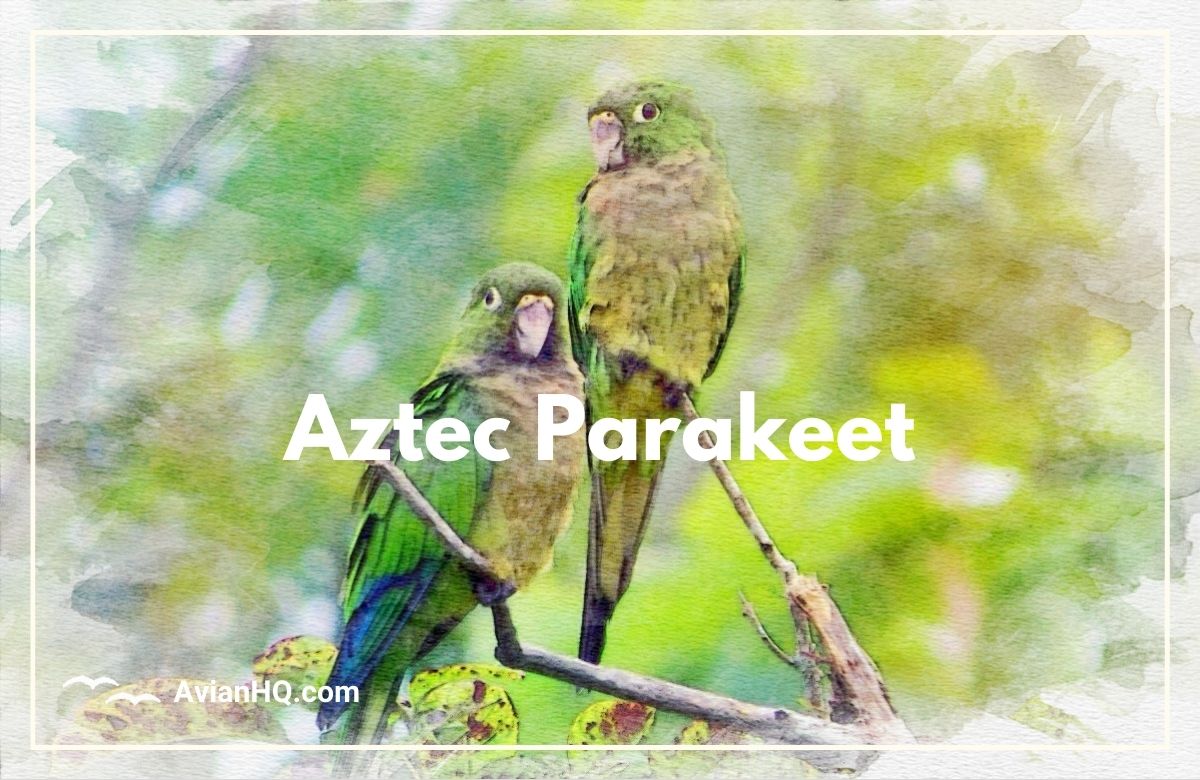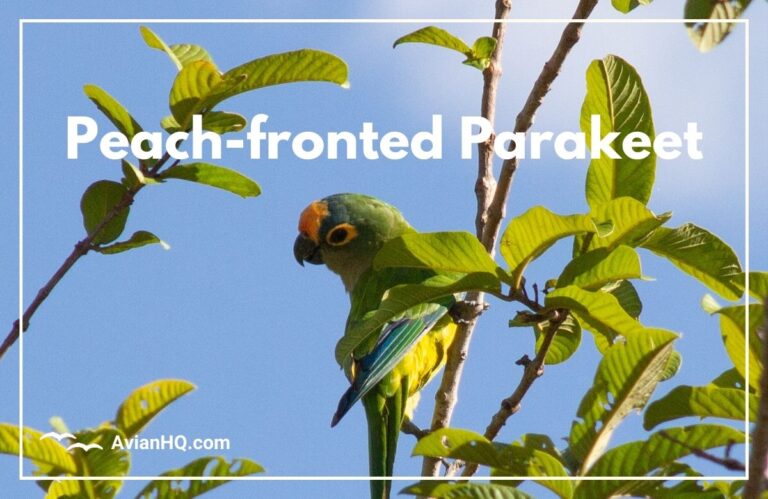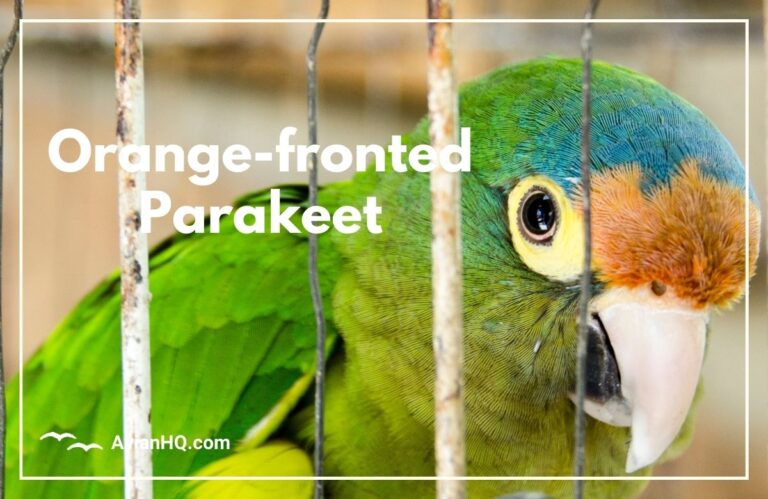Aztec Parakeet (Eupsittula astec)
Have you ever seen a bright green parakeet flying through trees or perched in a backyard? If you live in central Mexico or the American Southwest, it may well have been an Aztec Parakeet. These lively little parrots stand out with their vivid green plumage and long, pointed tail feathers.
You’ll most often find Aztec Parakeets in small, chatty flocks flitting through orchards and dry forests. They use their curved beaks to nibble on fruit, seeds, buds, and the occasional insect. Though these parakeets seem active and numerous, their range is limited to central Mexico and they face threats from the pet trade and habitat loss.
In this article, you’ll get an in-depth look at the unique traits and behaviors of the Aztec Parakeet. We’ll cover everything from its taxonomic classification to its interactions with other species. You’ll also learn about the Aztec Parakeet’s cultural significance, including its links to Aztec legends and use as a popular cage bird. Along the way, be prepared for some surprises, like the parakeet’s taste for the toxic seeds of cypress trees!
History and Taxonomy
The Aztec Parakeet entered the scientific literature in 1856 when it was first described by the French ornithologist Charles Lucien Bonaparte. He named the small green parrot Psittacara astec, grouping it with other Mexican parakeets under the genus Psittacara. This placement remained largely unchanged until 1997.
In the late 1990s, advances in genetics led to a reorganization of parrot taxonomy. Analyses of DNA showed that the Aztec Parakeet was only distantly related to the species in the Psittacara genus. Instead, scientists found its closest relatives to be Central American parakeets in the genus Eupsittula. As a result, the Aztec Parakeet was reclassified into this genus in 1997 under the name Eupsittula astec.
Today, the Aztec Parakeet resides comfortably as a member of Eupsittula, alongside six other closely related Central American species. Its nearest evolutionary relatives within this genus are Eaton’s Parakeet, the Olive-throated Parakeet, and the Brown-hooded Parakeet. All are small-to-medium sized parrots adapted for life in arid, subtropical habitats.
Physical Appearance
The Aztec Parakeet is a slender, long-tailed parakeet reaching approximately 11 inches (28 cm) in length. It is a vivid grass green in color, with some subtle variations in hue across its body plumage. The forehead and lore area have a yellowish tinge, while the primary wing feathers display a deeper bluish-green shade.
In terms of mass, these parakeets average 2.1-3.1 ounces (60-88 grams). Overall, the species exhibits little sexual dimorphism – males and females look alike to the casual observer. However, adult males tend to have brighter yellow-green plumage on the thighs and vent region. Juveniles resemble the adults, but their irises are dark grey rather than pale white.
The Aztec Parakeet’s most distinctive feature is its long, pointed tail which makes up nearly half its body length. This aids its agile flight through forests and orchards. Its bill is curved and bluish-grey in color, with a pale grey cere. The legs are also a blue-grey hue.
When seen up close, the bare patches of skin around the eyes stand out against the feathers. This eyering is white or pale blue, helping observers distinguish the Aztec Parakeet from similar species in its range.
Habitat and Distribution
The Aztec Parakeet inhabits a relatively small region of central and southern Mexico. Its range extends across the Mexican Plateau, covering parts of the states of San Luis Potosi, Hidalgo, Puebla and Veracruz. There are also small, isolated populations in Oaxaca and Guerrero.
This species is found at elevations between approximately 3,300 and 7,500 feet (1,000 – 2,300 meters). It occupies subtropical, inland areas rather than hot, humid lowlands or high mountain forests. The Aztec Parakeet thrives in a range of arid and semi-arid habitats such as pine-oak forests, orchard groves, palm stands, and patches of cypress trees.
The western periphery of the Aztec Parakeet’s range just reaches over the border into southeastern Arizona and southwest New Mexico. However, most records in the United States occur only when flocks stray north of the border during occasional irruptions. The species does not currently breed in the US, unlike many other parrots like the Red-crowned Parrot.
Within its core Mexican range, the Aztec Parakeet can be described as a locally common species. The expansion of fruit orchards likely boosted its numbers over the last century. However, its limited and fragmented distribution makes it vulnerable to habitat disturbances. Protecting isolated cypress groves is crucial for sustaining certain populations.
Diet and Feeding
The Aztec Parakeet utilizes its curved bill and agile nature to forage on a diverse mix of plant foods. This species could be described as a generalist herbivore, consuming buds, fruits, seeds, and flowers from a wide array of native trees and shrubs.
Some key food plants include cypress, juniper, oak, eucalyptus, torchwood, and Palo Verde. The parakeets supplement this mainstay of plant material with nutritious treats like corn, almonds and fruit crops. Their dexterous tongues allow them to extract seeds from pine cones and other tight places.
Insects and larvae provide a small but valuable portion of the Aztec Parakeet’s diet. It eats these animal protein sources while probing the bark and leaves of trees. Some orthopterans like grasshoppers and crickets may fall prey during summer and autumn months.
Aztec Parakeets feed socially, traveling in small flocks of 6 to 30 individuals through their home ranges. This covers areas of approximately 1,000 acres (400 hectares). At bountiful food sources like orchards, up to 200 birds may congregate. They exhibit feeding behaviors like clinging vertically or even upside down to access choice fruits and buds.
To crack hard nuts and seeds, Aztec Parakeets wedge them firmly in foot holds and dismantle them with their bills. These feeding techniques showcase the species’ flexibility and intelligence when utilizing seasonal food resources across its arid, subtropical range.
Breeding and Reproduction
The breeding season for Aztec Parakeets coincides with the onset of the annual rainy season across their Central Mexican range. Most mating and nesting activity occurs between May and August. However, some regional variations exist depending on localized conditions.
Aztec Parakeets are monogamous breeders. Mated pairs cooperate to choose nest sites, construct the nest structure, and care for resulting offspring. The birds prefer to nest in the natural tree cavities of dead snags. They also readily occupy crevices in vertical limestone or sandstone rock faces.
Nest construction is simple, with the parakeets arranging a base of chewed up wood chips. Upon this, the female lays a clutch of 3-5 small white eggs. She then incubates them for about 24 days while being fed by her partner.
Once hatched, the chicks are altricial – blind, naked and helpless. Both parents share feeding duties, regurgitating food to satisfy the nestlings. After 8-9 weeks, the juveniles are ready to exit the nest and join their parents on foraging outings.
Young Aztec Parakeets reach sexual maturity and begin bonding with mates at approximately two to three years old. Their average lifespan in the wild is unfortunately brief, only five to ten years. However habitat improvements and reduced trapping could boost survival rates.
Behavior and Ecology
The Aztec Parakeet is a highly social species, spending most of its time traveling and foraging in groups of 6-30 individuals. These flocks often mix with other Eupsittula parakeets, especially the Olive-throated Parakeet. Larger congregations may form at abundant food sources.
Flocks maintain cohesion via constant contact calls. If separated, the parakeets emit loud, far-carrying screeches to relocate fellow flock members. Predators like hawks elicit panicked, high-pitched alarm calls provoking the flock to scatter into dense foliage.
Roosting overnight in cavity trees or rock crevices provides protection from nocturnal predators. Breeding pairs often roost alone. However, social winter flocks containing multiple family groups may pile into a single roost.
Because of their small size, Aztec Parakeets fall prey to a range of native raptors. Known predators include the Aplomado Falcon, Bat Falcon, Cooper’s Hawk and Peregrine Falcon. Arboreal snakes like the Thick-tailed Racer also take nestlings. However, mobbing behaviors help deter certain predators.
Interactions with other species are not all negative. Aztec Parakeets provide a seed dispersal service for trees like cypress, juniper and palo verde through their far-ranging movements. Their abandoned nest cavities also create shelter opportunities for species like bats, owls, and woodpeckers.
Conservation Status
The Aztec Parakeet is currently classified as a species of Least Concern on the IUCN Red List of Threatened Species. Its large extent of occurrence and presumably healthy overall population size allows it this lower-risk categorization.
Across most of its range, habitat quality remains sufficient to sustain Aztec Parakeet populations. The expansion of agricultural land, orchards and non-native shade trees even boosted numbers last century. However, the species faces threats requiring monitoring.
The two major concerns are habitat loss and trapping for the pet trade. Fragmentation of native dry forests limits food resources and nest sites. Collection of juvenile birds from nests for illegal sale also reduces population growth each breeding season.
Regionally, the Aztec Parakeet meets higher threat criteria. For example, its population in Puebla suffers from severe deforestation. The isolated cypress groves this sub-population relies on are vulnerable to complete destruction without conservation measures.
While still reasonably secure overall, protected reserve areas and reforestation projects focused on key food trees would greatly benefit the Aztec Parakeet. Continued abundance of this species depends on maintaining habitat connectivity across its patchy subtropical ecosystems.
Cultural Significance
The Aztec Parakeet’s common name reflects the overlap between its range and the ancestral empires of Nahua peoples, including the Aztecs. However, clear references to this species in ancient Mesoamerican culture are lacking.
Modern indigenous Zapotec people of Oaxaca do appear to incorporate the Aztec Parakeet into folk tales. As a likely recent addition, it seems to have replaced extinct Caribbean macaws in cultural stories and songs.
Unfortunately, demand for the Aztec Parakeet’s vibrant plumage played a part in reducing macaw populations over previous centuries. Today it still draws the attention of illegal wildlife traffickers seeking to supply the pet trade.
In rural Mexican communities, Aztec Parakeets bring joy and color to backyards and orchards. Their high-pitched squawks announce the flock’s presence as they chatter and socialize. Many farmers tolerate these noisy but charismatic birds visiting fields to snack on ripe nut and fruit crops.
As awareness and appreciation continues growing for Mexico’s native parrots, further cultural significance and conservation value may coalesce around the Aztec Parakeet. Its accessibility, charm and intelligence are sure to win fans eager to ensure the species thrives far into future generations.
Conclusion
The vibrant little Aztec Parakeet proves you don’t need large size or brilliant red plumage to be counted as a true parrot. What it may lack in physical stature, it makes up for with an energetic nature and social, high-flying lifestyle.
Hopefully this overview of the species leaves you with an appreciation for its uniqueness within Mexico’s avifauna. We covered a wide range of topics, from its taxonomic history to its cultural symbolism for local communities. You now know key details about the Aztec Parakeet’s appearance, habitat, diet, breeding habits, threats and conservation status.
While still reasonably secure for now, habitat impacts in parts of its range give cause for monitoring this species in the coming decades. Organizations like the IUCN consider the Aztec Parakeet a species of Least Concern globally. However, regional declines in states like Puebla highlight the importance of sustaining isolated forest fragments housing smaller sub-populations.
The Aztec Parakeet remains a vibrant Mesoamerican endemic adapting to subtropical forest disturbance. Maintaining access to key nesting and feeding resources will determine its future in a human-altered landscape. This charismatic parakeet truly embodies the forests and culture of inland Central Mexico.








Loving the info on this internet site, you have done outstanding job on the articles.